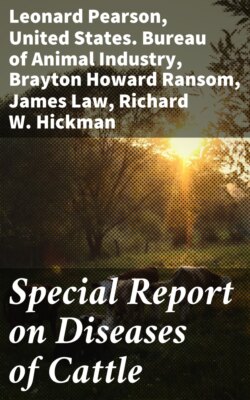Читать книгу Special Report on Diseases of Cattle - Lowe - Страница 104
На сайте Литреса книга снята с продажи.
THE PULSE.
ОглавлениеAs fully explained, the heart pumps the blood throughout the arterial system. The arteries are always full and each contraction of the ventricle pumps more blood into them; this distends their elastic walls and sends along them a wave which gradually becomes less perceptible as it nears the very small arteries. This wave constitutes the pulse, and is lost before the capillaries are reached. The sensation or impression given to the finger when placed upon the artery shows the force exerted by the heart and some important facts concerning the condition of the circulation. In adult cattle the average number of pulsations in a minute is from 50 to 60. The pulse is faster than normal after exercise, excitement, on hot days, from pain, and as a result of fullness of the stomach. In old animals it is slower than in the young and in males slightly slower than in females. In fevers and inflammations and in local diseases of the heart the pulse rate is increased. If the rate is greater than 100 or 110 to the minute the outlook for recovery is not good.
Other variations of the pulse are known as infrequent pulse, which means that the number of pulsations in a given time is less than normal. The irregular or the intermittent pulse is when the pulsations do not follow in regular order. The large pulse and the small pulse refer to the volume of the pulse, which may be larger or smaller than usual. The strong pulse and the feeble pulse refer to the strength or weakness of the pulsation. The pulse is said to be hard when the vessel feels hard and incompressible, the soft pulse being the opposite. By dicrotic pulse is meant that kind of pulsation which makes each beat seem double, and therefore it is generally called the double pulse.
The venous or "jugular pulse" is the pulsation so frequently observed in the jugular vein of cattle and is particularly noticeable while they are ruminating—"chewing the cud." It is not always associated with disease, but may be a symptom of some disease of the heart; in such cases the jugular pulse is continuous.
The place selected for feeling the pulse in cattle is where the submaxillary artery winds around the lower jawbones, just at the lower edge of the flat muscle on the side of the cheek; or, if the cow is lying down, the metacarpal artery on the back part of the fore fetlock is very convenient for the purpose.
